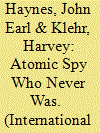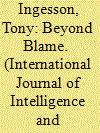|
|
|
Sort Order |
|
|
|
Items / Page
|
|
|
|
|
|
|
| Srl | Item |
| 1 |
ID:
186398


|
|
|
|
|
| Summary/Abstract |
In the late 1980s and early 1990s the KGB and its successor SVR began a campaign to claim a large share of credit for the USSR’s development of an atomic bomb. Memoirs by KGB officers celebrated their service’s success in penetrating the American “Manhattan” project. As part of this campaign, in 1991, Vladimir Chikov, a serving KGB (later SVR) officer, published an article in Russian and English, followed by a full-length book in French (1996), German (1996), and Russian (1997) on the exploits of an atomic superspy code named “Perseus,” said to still be alive and unknown to American security. “Perseus” was described as a senior physicist who was part of the Manhattan project from its origins, working first at the Chicago “Med” lab with Enrico Fermi and later at Los Alamos with Robert Oppenheimer. Veteran KGB officer Anatoly Yatskov, who had supervised several spies in the Manhattan project, added his endorsement of the “Perseus” story. For years, amateur and professional researchers used the clues in Chikov’s writings to search for the identity of “Perseus,” but no strong candidate emerged. With the opening of the Venona decryptions in 1995, most professional historians became convinced that “Perseus” was a KGB/SVR fiction, but “Perseus” lingers still with the wider public as a yet unidentified Soviet atomic spy. This article points to the internal contradictions and impossible assertions in Chikov’s “Perseus” story, as well as how Venona shows that Chikov took elements of the story of a real Soviet spy, Theodor Hall, to construct the “Perseus” myth. Hall was a junior scientist without an advanced degree who worked at Los Alamos in 1944 and 1945 (never at Chicago), but Chikov moved Hall’s story back to 1942 and elevated him from a junior figure to a senior scientist and associate of Fermi and Oppenheimer who, in Chikov’s words, gave Stalin “the Manhattan project on a serving plate.” Further, Chikov gave “Perseus” numerous attributes that precluded the still living Hall from ever being a candidate for the atomic spy “Perseus.”
|
|
|
|
|
|
|
|
|
|
|
|
|
|
|
|
| 2 |
ID:
186403


|
|
|
|
|
| Summary/Abstract |
Investigations into intelligence failures are frequently conducted by multiple parties in parallel, and in several important cases, their conclusions have been controversial. In addition, investigations into minor incidents, such as mishandling of sensitive information or equipment, tradecraft errors, or similar events where no major consequences have been detected, tend to be handled internally by the concerned agency, or through limited interagency cooperation. This can lead to missed opportunities to prevent them from developing into major failures. These issues are compared to the investigative procedures employed in the aviation safety sector, where an independent body is responsible for investigating both major failures and minor incidents, with a view specifically to develop proactive measures to prevent repetition. The conclusion presented is that the Intelligence Community could benefit from studying how aviation safety investigations are handled, in order to be more effective in addressing minor incidents at an early stage, and to avoid controversies in investigations of major events.
|
|
|
|
|
|
|
|
|
|
|
|
|
|
|
|
| 3 |
ID:
186401


|
|
|
|
|
| Summary/Abstract |
Cloud, grid, parallel, volunteer, and opportunistic computing are different forms of distributed computing and each of these concepts addresses different problems in data analysis. One of the latest virtualization technologies, containerization, provides new capabilities with a thin layer on end-user desktop computers in the field of distributed computing. From the viewpoint of management information systems, the information is the key element in decisionmaking processes, and in the age of the Internet the information that is necessary for organizations is accessible from publicly available open sources. Every organization needs to operate an open-source intelligence process to use the open-source data in different levels of management. However, the problem is that each organization needs data scientists and hardware and software resources to fulfill this requirement. Big enterprise companies or governments can make an investment to solve this problem, but small and medium-sized enterprises or small institutions may not have enough budget. A distributed microservice-based data analysis model with the technology of Docker containerization on the end-user computers is proposed.
|
|
|
|
|
|
|
|
|
|
|
|
|
|
|
|
| 4 |
ID:
186400


|
|
|
|
|
| Summary/Abstract |
How securely did Soviet leader Nikita Khrushchev handle secret intelligence? Former Soviet officials have claimed that he carelessly revealed intelligence and certainly in conversations with American, Italian, and Iranian diplomats and ministers Khrushchev put at risk Soviet sources by boasting about intelligence successes and disclosing information that could only have come from intelligence. While Soviet officials appear to have overestimated the security impact of Khrushchev’s revelations, he may have compromised a covert KGB mission in Iran and an important surveillance operation against the American embassy in Moscow.
|
|
|
|
|
|
|
|
|
|
|
|
|
|
|
|
| 5 |
ID:
186399


|
|
|
|
|
| Summary/Abstract |
Drawing on the formerly classified in-house journal KGB Collection, this article argues that active measures, commonly known as Soviet foreign influence operations, were the concept and practice in which offensive counterintelligence encroached on foreign intelligence functions. In the 1960s, KGB counterintelligence officers were urged to implement active measures, instead of passive surveillance, by cultivating and recruiting foreign visitors and Soviet citizens with the aim of using them to penetrate Western institutions and collect sensitive intelligence. The counterintelligence directorate occasionally supervised foreign operations to implement offensive tactics. Given the parallels between the Soviet and Russian intelligence services, the expansion of the counterintelligence agency (the Federal Security Service) in post-Soviet Russia can be interpreted as its increased interest in and capabilities for active measures abroad.
|
|
|
|
|
|
|
|
|
|
|
|
|
|
|
|
| 6 |
ID:
186402


|
|
|
|
|
| Summary/Abstract |
Intelligence services—among other entities—must organize information in ways that facilitate their operations. The information technology (IT) that agencies develop follows the contours of how agencies use data in furtherance of their objectives. Therefore, it can be read as a microcosm of agencies writ large. The Federal Bureau of Investigation (FBI)’s use of IT provides a case study of this. IT evolved to serve the needs of individual programs (e.g., counterintelligence, criminal investigations) and only once this had occurred did the FBI begin to develop a corporate enterprise architecture aimed at integrating the organization’s multiple facets. Examining the evolution of the FBI’s IT serves multiple purposes. From a historical perspective it provides insights into the institutional thought process, reflected in IT decisions, that drove operations. It also provides a lens through which to assess future development of IT systems—specifically, how an IT decision will impact the FBI’s culture and ability to effectively carry out its mission.
|
|
|
|
|
|
|
|
|
|
|
|
|
|
|
|
|
|
|
|
|